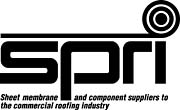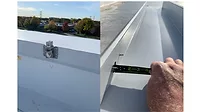SPRI Builds on Record of Accomplishment

"One of SPRI's goals is to provide reference tools to make the job of roofing more consistent and reliable," reports SPRI technical director Dave Roodvoets. For example, SPRI has devoted considerable resources to developing and canvassing a number of standards that have been promulgated with the American National Standards Institute. America's first national standard for retrofit roof drains, developed by SPRI, was just recently approved as a national standard in accordance with ANSI protocol. This new standard is designated ANSI/SPRI RD-1, 2003, "Standard for Retrofit Roof Drains."
This standard fills the information gap by detailing measures that should be taken to achieve leak-free connections to existing drain piping as well as to provide sufficient drainage. Prior to the publication of this ANSI/SPRI standard, there were no national guidelines for installing retrofit drains within an existing roof system.
Another SPRI initiative, a new pull-test procedure for insulation adhesives, is currently being canvassed for approval as a national standard. SPRI members developed this uniform field test method to evaluate the suitability of adhesives for attaching insulation or coverboard to a substrate. It is entitled "Standard Field Test Procedure for Determining the Load Resistance of Insulation Adhesives over Various Substrates."
SPRI earned its certification as an official ANSI canvasser in 1994. Since then, it has seen the acceptance of several of its design documents as ANSI standards. Furthermore, to keep these standards current, they are re-canvassed every five years. Other ANSI/SPRI standards include: ANSI/SPRI FX-1 2001, Standard Field Test Procedures for Determining the Withdrawal Resistance of Roofing Fasteners; ANSI/SPRI RP-4 2002, Wind Design Standard for Ballasted Single-Ply Roofing Systems; and ANSI/SPRI ES-1 2003, Wind Design Guide for Edge Systems Used with Low-Slope Roofing Systems.
"ANSI/SPRI standards are all readily referenced tools that the roofing contractor can use to develop job specifications or to evaluate the performance of products," Roodvoets explains. "Having ANSI-recognized standards provides consistency among products and even more assurance that products meeting these standards will perform, therefore reducing the contractor's risk."
In addition, SPRI recently published the latest version - its seventh - of its comprehensive manual, "Flexible Membrane Roofing; A Professional's Guide to Specifications." This updated edition now includes generic installation details and adhesive information. It is offered in a CD-ROM format.
Joint efforts by SPRI and the National Roofing Contractors Association saw the formal submission of two more ASTM (American Society for Testing and Materials) standards for specific flexible roofing membranes formally submitted last fall at code hearings into the International Code Council building code. The two membranes under consideration are TPO (thermoplastic polyolefin)- and KEE (ketone ethylene ester)-based materials. Pending a final vote, these measures should make it easier for roofing contractors to pull building permits and get widespread product acceptance for a broader range of flexible membrane roofing systems.
On another front, SPRI sponsored an extensive, three-year study with Oak Ridge National Laboratory on how reflective roof membranes age. Researchers studied the results of aging on 18 different types of flexible roof membranes, supplied by 10 different manufacturers. The original colors of these membranes ranged from whites to tans and grays. They discovered that reflectivity declines level out after about two years and can be restored with simple cleaning measures (in accordance with manufacturers' maintenance recommendations). Researchers concluded that decreases in reflectivity seem to be caused by a biomass - either a fungus or a cyano-bacterium - growing on the membrane surface in the presence of moisture, dirt and other contaminants, and influenced by temperature. Decreased reflectivity did not seem to be caused by an initial breakdown in a membrane's formulation or polymer content.
"SPRI's most valuable role," sums up SPRI President Mike Ennis, "is that it provides a forum to utilize the collective expertise of its members to resolve a wide variety of issues facing the roofing industry."
Looking for a reprint of this article?
From high-res PDFs to custom plaques, order your copy today!




